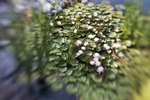
Two water frogs often show up in the aquarium trade. The African dwarf frog and the African clawed frog have similar care in the aquarium, with a few minor differences. Specifically, the larger clawed frog has issues sharing its aquarium. However, the dwarf frog has similar compatibility to a small, peaceful aquarium fish.
Telling Them Apart
There are several species of the clawed frog and dwarf frog, but the care for each type of frog is the same. However, clawed frogs grow larger and have a more predatory behavior, so you must make sure you're getting the frog you think you're getting. You can tell them apart by looking at their front legs. Dwarf frogs have webbed fingers, while clawed frogs do not have webbing on their front paws. This gives clawed frogs their clawed look. Clawed frogs also grow several times larger than dwarf frogs, but a juvenile specimen can pass for a dwarf frog.
Dwarf Frogs
Dwarf frogs (Hymenochirus spp.) stay under two inches. They get along well with other fish. In fact, the only concern with keeping them with fish is that larger or aggressive fish may pick on the dwarf frogs. They prefer tropical temperatures in the 70s. Dwarf frogs will eat fish flakes readily, but relish the occasional live treat, like blood worms, brine shrimp or mosquito larvae. Additionally, they get along well with other members of their own species.
Clawed Frogs
Clawed frogs (Xenopus spp.) reach an adult size of 5 to 8 inches depending on the exact species. They are enthusiastic carnivores, and will readily eat their dwarf frog cousins. In fact, clawed frogs will eat almost any animal smaller than themselves. Their mouths open wide enough that they can pose a threat to other animals almost the same size as themselves. Genetics researchers often use clawed frogs as model organisms, as their genome is well understood.
Cautions
You should never release any aquarium pet into the wild, but clawed frogs deserve a special admonition. The predatory nature and ability of clawed frogs to adapt to a wide variety of conditions has made them invasive in many areas. In fact, some states have banned clawed frogs due to the danger of them disrupting native ecosystems. Never release a clawed frog into the wild.
References
Photo Credits
-
Stockbyte/Stockbyte/Getty Images




